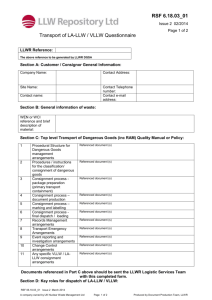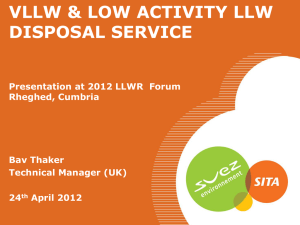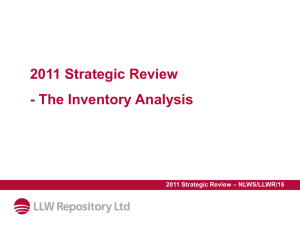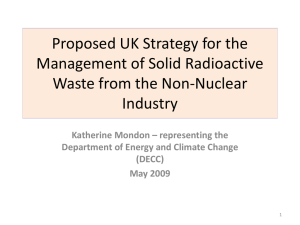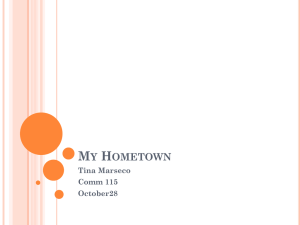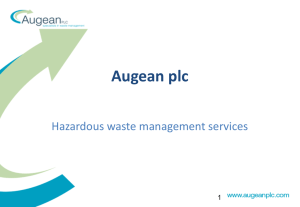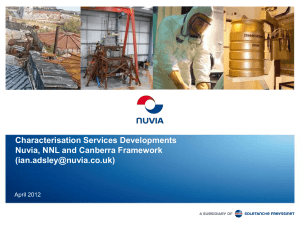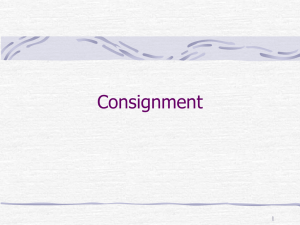Waste Management Services 2b. VLLW Staged Project Delivery
advertisement
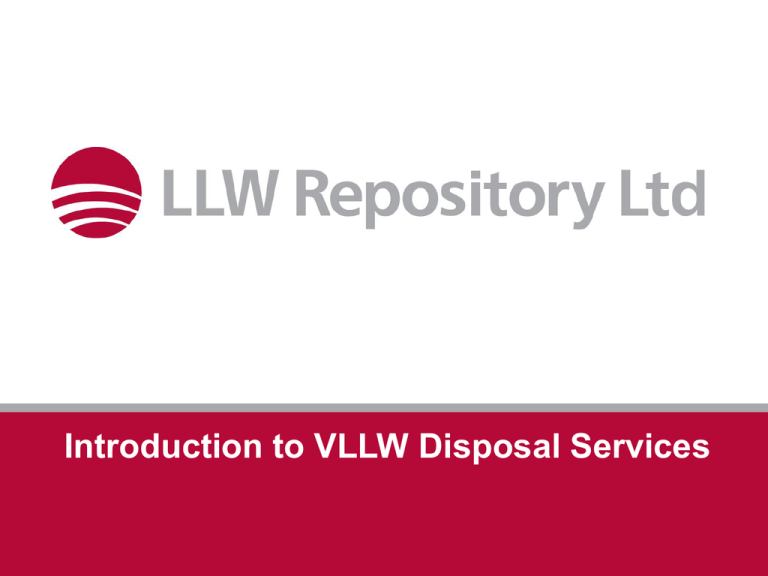
Introduction to VLLW Disposal Services 1 Introduction to VLLW Disposal Services Alex McCarthy, Waste Services Contract Manager Objectives 1. Establishing the Service, a. Establishing the service and managing nuclear liability b. Our service summarised 2. Introduce the service and how it will work, a. Key documents in the Waste Services Contract b. VLLW Staged Project Delivery 3. Service development, a. Near term service development b. Medium / Long term service development 1a. Establishing the service and managing nuclear liability • Supply Framework established following a competitive tender exercise • Customers access service through the Waste Services Contract (v3) – Special Conditions manage the specific needs of this service • Problem: How to manage the transfer of Nuclear Liability for SLCs – Reduce burden on SLCs for managing VLLW disposed at other sites – Provide clarity on who holds liability after waste disposed – Reduce risk of multiple tenuous claims • Our solution: LLWR acts as channelling entity – Single SLC acting as the liable Party – Amended Insurance Policy in place – Service specific delivery process 1b. Our service summarised • Delivered using the Waste Services Contract (v3) • LLWR will accept the nuclear liability via relevant carriage, and our approach reflects this • The Waste Acceptance Procedure will apply with a customised consignment stage • Gated project development and delivery model • Onsite witnessing required 2a. Key documents in the Waste Services Contract • Waste Acceptance Criteria • Relating to the Waste Acceptance Procedure – Compliance Dossier – QP037 Quality Plans for project and consignment specific – Waste Transfer Forms for each load 2a. Key documents in the Waste Services Contract • VLLW Waste Acceptance Criteria – An overview document describing the VLLW Service as a whole – Common format • Selected points from WAC – Physical and Chemical Properties – Packaging and Transport Requirements – Radiological Properties 2a. VLLW WAC - Summary Waste Treatment and Segregation (V1) • • Waste should not be consigned for disposal if reasonably practicable measures could be adopted to reduce the final volume requiring disposal. Where waste is not selected for treatment, acceptance will require Suitable Supporting Justification to be provided. Approved Waste Packages and Transport Containers (V3) • • Waste for Very Low Level Waste disposal may be consigned to LLW Repository Ltd or the Service Suppliers in a wide range of Waste Packages and Transport Containers. The acceptable range of Waste Packages includes 210 litre Drums and Soft Sided Packaging. 2a. VLLW WAC – Summary Radioactivity Limits (V2) • Service Supplier specific criteria for Activity limits apply for Low Activity Low Level Waste and Very Low Level Waste. Specific restrictions will be determined through the Waste Enquiry Process. However, the following criteria provide a general guide: Table 1: Specific Activity Limits Radionuclide Specific Activity (MBq/t) Acceptable Likely to be Accepted All <4 <200 Tritium <40 <200 2a. Compliance Dossier • It is the collected evidence gathered to demonstrate compliance with all necessary rules, regulations, and permits in delivering the disposal service • Compliance Dossier divides all evidence and activities into six distinct stages, which are, 1. Project Initiation 2. Service Definition 3. Consignment Preparation 4. Project Execution (Consignment and Disposition) 5. Audit Reports 6. Communications and Notifications • Designed for our initial projects 2a. Quality Plan – QP037 • Comprises two sections, – QP037A Covers project activities at Pelham House (Stage A, B, C, E, and F) – QP037B Covers individual load activities in the field (Stage D) • Confirms that specified activities have been completed and evidence has been gathered • Structure mirrors the Compliance Dossier template • Further guidance at www.llwrsite.com under Logistics Services – VLLW / LA-LLW Transport Guidance Note PAA/GN06 2a. Waste Transfer Form • Expected VLLW service characteristics, – – – – Large volume, low activity High number of consignments per project Commonality between individual consignments Potential for increased administrative burden • Needed to evolve to maintain quality whilst reducing paperwork • Need to align with new Service Providers • Small number of Over-arching WCI Forms (Parent) • Numerous Waste Transfer Forms (Children) 2b. VLLW Staged Project Delivery STAGE A Project Initiation WEN BAT EPR / RSA WCH Analyses Upon approval proceed to Stage B Waste Management Services 2b. VLLW Staged Project Delivery STAGE B Service Definition WSQ RA Preacceptance MSDS Programme Activity assess Consign model Upon approval proceed to Stage C Waste Management Services 2b. VLLW Staged Project Delivery STAGE C Consignment Preparation Compliant with WAC Verification WAC Packaging Loading Transport / b / g assessed Variations Upon approval proceed to Stage D Waste Management Services 2b. VLLW Staged Project Delivery STAGE D Project Execution Consigning document Pre-loading Loading Waste Transfer form Dispatch procedure Disposal Acceptance Ongoing Monitoring Evidence gathered during delivery Waste Management Services 2b. VLLW Staged Project Delivery • Stages that cover entire lifecycle • Section E: Audit Reports – Duty of Cares, Transport Audits, Audits required by Service Provider or Customer – Must be completed before progression to Stage D • Section F: Communications and Notifications – Regulatory / Authority notifications – Stakeholder communications – Check of whether new comms plan is required (determined according to project) – Must be completed after Stage A, but before Stage D Waste Management Services 2b. VLLW Staged Project Delivery • • LLWR witnessing schedule defined per project The minimum requirements for witnessing are, 1. the packaging of waste for the first consignment 2. the loading of packages onto the conveyance for the first consignment, and subsequently for any change to the WLP 3. the despatch monitoring of packages for first consignment 4. the transport consignment of waste for the first consignment and any changes in radiological transport classification 5. Receipt of waste at landfill for the first consignment 6. Disposal of the first consignment • • LLWR is observing not supervising LLWR control through paperwork approvals Waste Management Services 3a. Near Term Service Development • Deliver the service safely and responsibly • Live projects – 1 project currently at execution stage (LLWR Service Commissioning Project) – Several projects at preparatory stage (Normal business) • Open up all new disposal routes • React to Customer Waste Enquiries 3b. Medium / Long Term Service Development • Medium term (12 – 18 months) – Analysis of Waste and Inventory Data – identify opportunities – Early and targeted engagement at the decommissioning stage • Long Term (2 – 5 years) • Changes to the Paris and Brussels Conventions on Nuclear Third Party Liability – 2011 Public Consultation • Decoupling of Licensing and Liability • Application to remove the need for licensing for LLW Disposal sites • Open up the market and remove LLWR from channelling role Recap of Objectives 1. Establishing the Service, a. Establishing the service and managing nuclear liability b. Our service summarised 2. Introduce the service and how it will work, a. Key documents in the Waste Services Contract b. VLLW Project Delivery 3. Service development, a. Near term service development b. Medium / Long term service development Key Points • Contact your Service Delivery representative for more information • Access the service via the Waste Services Contract (if required) • Service will involve LLWR site witnessing and greater planning than normal • One key issue is stakeholder perception of risk – Our priority is safe and responsible development and delivery of the service – Programme and price follow this Questions?
